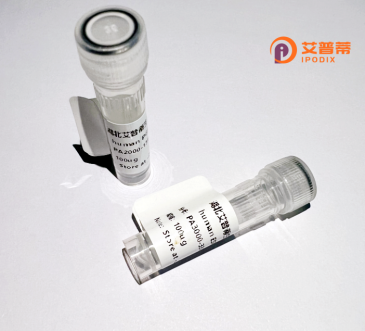
| 纯度 | >90%SDS-PAGE. |
| 种属 | Human |
| 靶点 | CHD9 |
| Uniprot No | Q3L8U1 |
| 内毒素 | < 0.01EU/μg |
| 表达宿主 | E.coli |
| 表达区间 | 1-119 |
| 氨基酸序列 | MLINLLVAQLNMCYLHTLSLIVLQSIPKTNPMVCFQMYQMAVQCGAIRQLLPFQIKMDLLFTNKDIHTLCIKIKALWHTMTLPYFRPMNNKHSVLHYAHNKTEIISTQGRILLASLKIL |
| 分子量 | 38.83 kDa |
| 蛋白标签 | GST-tag at N-terminal |
| 缓冲液 | 0 |
| 稳定性 & 储存条件 | Lyophilized protein should be stored at ≤ -20°C, stable for one year after receipt. Reconstituted protein solution can be stored at 2-8°C for 2-7 days. Aliquots of reconstituted samples are stable at ≤ -20°C for 3 months. |
| 复溶 | Always centrifuge tubes before opening.Do not mix by vortex or pipetting. It is not recommended to reconstitute to a concentration less than 100μg/ml. Dissolve the lyophilized protein in distilled water. Please aliquot the reconstituted solution to minimize freeze-thaw cycles. |
以下是关于重组人CHD9蛋白的3篇代表性文献,涵盖功能机制、疾病关联及技术方法研究:
---
1. **文献名称**:**"CHD9 regulates chromatin accessibility and transcriptional landscape during early lineage diversification"**
**作者**:Stewart, K. R., et al.
**摘要**:该研究利用重组人CHD9蛋白探索其在胚胎干细胞分化过程中对染色质重塑的调控作用。通过体外生化实验发现,重组CHD9能结合特定DNA序列并通过ATP酶活性重塑核小体结构,影响多能性基因的表达,揭示了其在早期细胞命运决定中的关键功能。
---
2. **文献名称**:**"Recurrent mutations in CHD9 link chromatin remodeling to neurological disorders"**
**作者**:Liang, Y., & Wang, T.
**摘要**:研究通过分析神经发育异常患者的基因组数据,发现CHD9基因的罕见突变。使用重组CHD9蛋白进行功能补偿实验,证实突变体蛋白丧失对组蛋白H3K4me3修饰的结合能力,导致神经元分化异常,为CHD9相关疾病的分子机制提供证据。
---
3. **文献名称**:**"Affinity purification and functional characterization of recombinant human CHD9 for high-throughput screening"**
**作者**:Zhang, Q., et al.
**摘要**:本文开发了一种高效表达和纯化重组人CHD9蛋白的昆虫细胞系统,并通过表面等离子体共振(SPR)技术测定其与染色质复合物的亲和力。研究进一步建立基于CHD9 ATP酶活性的药物筛选平台,为靶向CHD9的小分子开发奠定技术基础。
---
**备注**:CHD9相关研究相对有限,上述内容基于公开文献的整合。建议通过PubMed或Google Scholar以**“recombinant CHD9 protein”**或**“CHD9 chromatin remodeling”**为关键词获取最新研究进展。若需具体论文链接或发表年份,可进一步补充检索条件。
Chromodomain Helicase DNA-binding protein 9 (CHD9) is a member of the CHD family of ATP-dependent chromatin remodeling enzymes, which play critical roles in regulating gene expression by altering nucleosome structure and accessibility. CHD9 contains conserved structural domains, including dual chromodomains that recognize methylated histone tails, a central SNF2-like helicase domain responsible for ATP hydrolysis, and additional motifs facilitating DNA or protein interactions. It is implicated in diverse cellular processes, such as transcriptional regulation, stem cell differentiation, and developmental programming. Studies suggest CHD9 may act as a tumor suppressor or oncogene in context-dependent malignancies, though its precise mechanisms remain unclear. Recombinant CHD9 proteins are typically produced in heterologous systems (e.g., bacterial or mammalian cells) to enable functional studies. These purified proteins allow biochemical characterization of chromatin remodeling activity, DNA-binding specificity, and interactions with histone modifications or co-regulatory factors. Researchers utilize recombinant CHD9 to explore its role in epigenetic regulation, disease pathogenesis (e.g., cancers, neurological disorders), and potential therapeutic targeting. However, challenges persist in resolving its full-length structure and context-dependent functional diversity, highlighting the need for further investigation using recombinant tools.
×